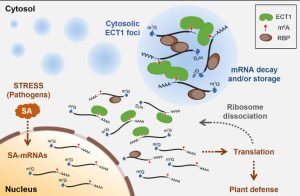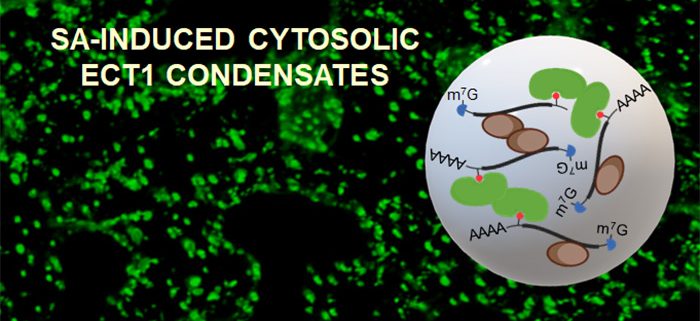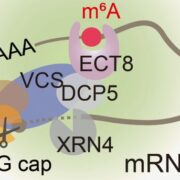Epitranscriptional regulation of salicylic acid signaling
Lee, Liu, Kim et al. demonstrate that a plant m6A reader dampens stress responses.
By Keun Pyo Lee, Kaiwei Liu, Eun Yu Kim, and Chanhong Kim
CAS Center for Excellence in Molecular Plant Sciences (CEMPS), Chinese Academy of Sciences (CAS)
https://doi.org/10.1093/plcell/koad300
Background: mRNAs undergo various modifications. N6-methyladenosine (m6A) is the most prevalent epigenetic modification in eukaryotic mRNAs. A network of enzymes called m6A “writers” and “erasers” reversibly regulates this modification, affecting various aspects of mRNA metabolism through proteins called m6A “readers”. m6A readers contain the YTH domain responsible for m6A binding. The m6A modification plays pivotal roles in plant physiological responses, including growth, development, and stress responses. However, the biological significance of m6A readers and their mode of action in mRNA metabolism are largely unknown. Moreover, unlike in animals and yeast, many m6A readers in plants have yet to be identified.
Question: Based on our previous finding that multiple YTH family proteins interact with LESION SIMULATING DIEASE1 (LSD1), a negative regulator of salicylic acid (SA)-induced cell death, we sought to uncover their roles as SA-responsive m6A readers and their impact on SA-driven stress responses in Arabidopsis (Arabidopsis thaliana).
 Findings: Among the 13 YTH family proteins in Arabidopsis, we identified EVOLUTIONARILY CONSERVED C-TERMINAL REGION1 (ECT1) as a crucial player in SA-mediated stress responses. Loss of ECT1 enhances SA-primed growth retardation and cell death. ECT1 undergoes liquid-liquid phase separation, forming cytosolic biomolecular condensates such as processing bodies and stress granules, sites for decay and/or storage of non-translating mRNAs, in response to SA or bacterial pathogens. It sequesters SA-induced m6A modification-prone mRNAs (SA-m6A-mRNAs), facilitating their decay in cytosolic biomolecular condensates, thus compromising SA-mediated stress responses. Arabidopsis plants overexpressing ECT1 are more susceptible to bacterial pathogens.
Findings: Among the 13 YTH family proteins in Arabidopsis, we identified EVOLUTIONARILY CONSERVED C-TERMINAL REGION1 (ECT1) as a crucial player in SA-mediated stress responses. Loss of ECT1 enhances SA-primed growth retardation and cell death. ECT1 undergoes liquid-liquid phase separation, forming cytosolic biomolecular condensates such as processing bodies and stress granules, sites for decay and/or storage of non-translating mRNAs, in response to SA or bacterial pathogens. It sequesters SA-induced m6A modification-prone mRNAs (SA-m6A-mRNAs), facilitating their decay in cytosolic biomolecular condensates, thus compromising SA-mediated stress responses. Arabidopsis plants overexpressing ECT1 are more susceptible to bacterial pathogens.
Next steps: Considering the phenotypic similarity between ect1 and ect2 mutants upon SA treatment, we wish to investigate the functional interplay and inter-dependency between ECT1 and ECT2 in SA-dependent plant stress responses. Moreover, apart from ECT1 function in SA-m6A-mRNA decay, we will explore its potential role in stabilizing other subsets of m6A-mRNAs, likely within stress granules.
Reference:
Keun Pyo Lee, Kaiwei Liu, Eun Yu Kim, Laura Medina-Puche, Haihong Dong, Minghui Di, Rahul Mohan Singh, Mengping Li, Shan Qi, Zhuoling Meng, Jungnam Cho, Heng Zhang, Rosa Lozano-Duran, and Chanhong Kim. (2023). The m6A reader ECT1 drives mRNA sequestration to dampen salicylic acid–dependent stress responses in Arabidopsis. https://doi.org/10.1093/plcell/koad300





